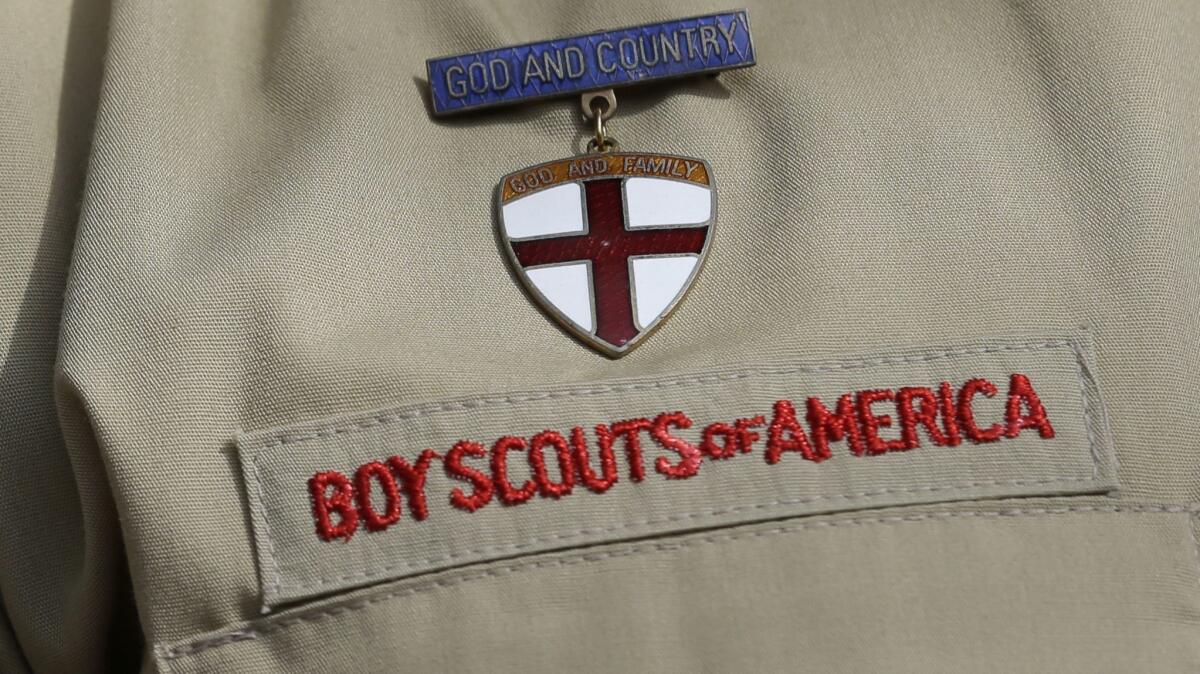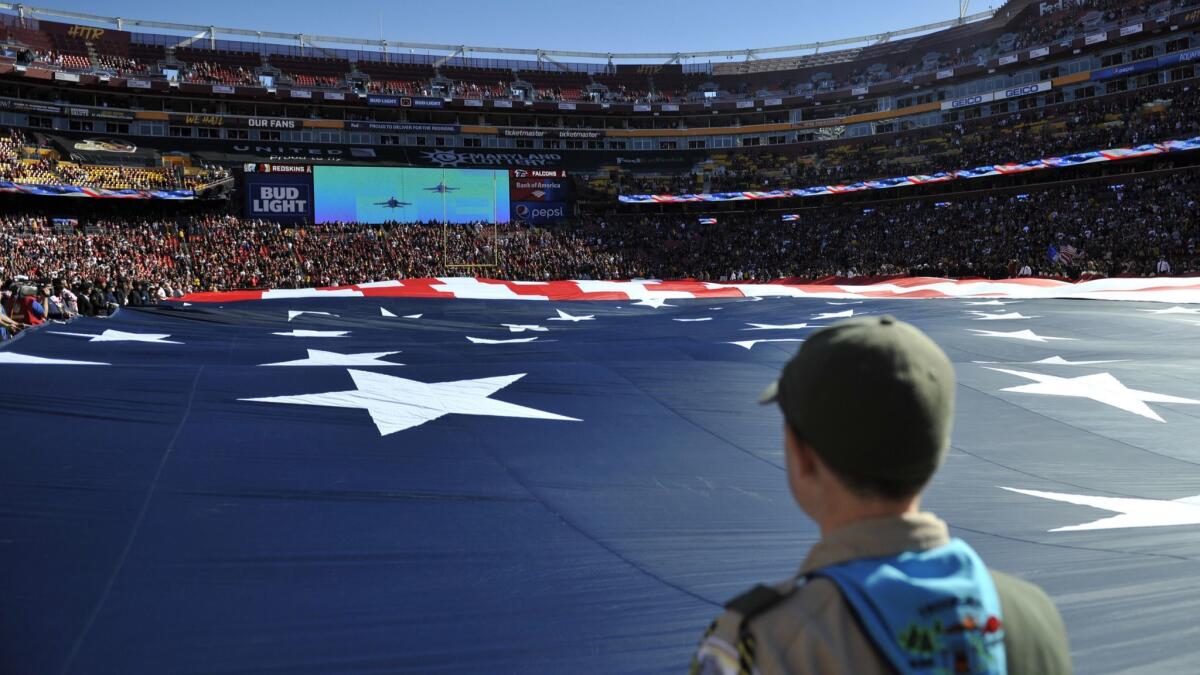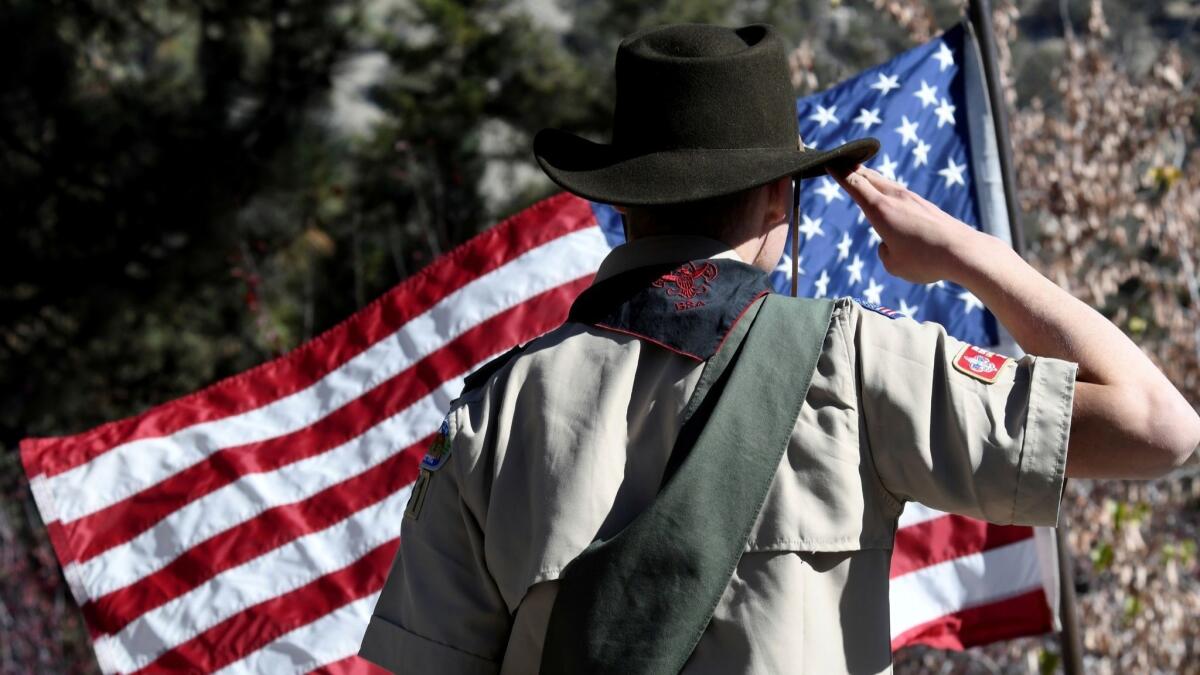Bankruptcy on the table as Boy Scouts confront sex abuse claims

- Share via
It took Robb Lawson until he was 45 to finally confront a dark memory from his days as a Boy Scout.
Lawson was a teenager at the time, a member of a troop in Georgia, picked to attend a wilderness challenge to win entry in the Scouts’ prestigious Order of the Arrow. He recalls that he wasn’t feeling well, and a trip leader took him to a tent and raped him.
The lawsuit he filed against the Boy Scouts of America in 2016 represented a personal turning point for Lawson. For the Boy Scouts, his story reflects the nationwide scandal and financial stakes that have pushed the 108-year-old organization to consider filing for bankruptcy.
Earlier this month, Chief Scout Executive Michael Surbaugh acknowledged media reports that the group was considering Chapter 11 protection, saying it’s “exploring all options available” to ensure that scouting programs continue uninterrupted. Nothing’s been decided, said Boy Scouts spokeswoman Effie Delimarkos in an email. “It’s due diligence for an organization whose motto is ‘be prepared’ to explore all of our opportunities and pathways forward.”
The Scouts are fighting hundreds of claims, a rash of litigation fueled by the public emergence in 2012 of the organization’s own meticulous records of thousands of sexual abuse and misconduct allegations. BSA executives say the documents — known as the “ineligible volunteer files” — were part of their system for protecting kids by weeding out those who shouldn’t have been allowed to work with them.
Plaintiffs and their lawyers call it something else: evidence of a massive cover-up that endangered other children and, in the words of Lawson’s suit, “put scouting’s image and financial interests — its ‘brand’ — ahead of the safety of the scouts.”
Already under pressure from declining enrollment, the Scouts have worked to minimize the financial impact of sex abuse litigation. The group has paid more than $11 million to the law firm leading its legal defense and has doubled its level of insurance reserves since the records were made public. The group has also raised dues and, in the interest of reaching a new audience, opened its programming to girls starting next year, when the traditional scouting program will be renamed Scouts BSA.
It’s also in court with its insurance companies, which argue that they shouldn’t have to pay claims related to abuse that the Scouts could have reasonably prevented. BSA and several councils sued the Hartford Accident and Indemnity Co. and First State Insurance Co. in Texas for $13.5 million in June, after the insurers argued that BSA’s own records showed the organization hadn’t done enough to warn or protect kids. These weren’t unrelated incidents, according to the insurers, but all the result of the organization’s failure to warn parents of the risk. In a different legal dispute, insurers are refusing to pay for sex-abuse settlements and legal defense fees, arguing that the events weren’t accidents, or even unforeseen.
“We have a social and moral responsibility to fairly compensate victims who suffered abuse during their time in Scouting, and we also have an obligation to carry out our mission to serve youth, families and local communities,” Surbaugh said in his statement. “At no time in our history have we knowingly allowed a sexual predator to work with youth, and we always seek to act swiftly when alerted to abuse allegations.”
At the same time, the organization has lobbied lawmakers in various states to limit its exposure — seeking to defeat measures that would give child victims more time to claim damages as adults. Last year, the Boy Scouts spent almost $950,000 on lobbying, four times its average over the previous five years.

More kids participate in the Boy Scouts than in almost any other American organization. Even after years of declining enrollment, more than 2 million youth participated in its programs in 2017, where they were supervised by 889,000 adult leaders.
Since the 1980s, the Boy Scouts have made active efforts to address and prevent sex abuse, Delimarkos said. Volunteers have to pass background checks and complete youth-protection training every two years. Rules prohibit one-on-one contact between adults and kids, on social media and in person. All volunteers and employees are required to go to law enforcement with any allegations or suspicions of abuse. There’s a 24-hour help line for reporting concerns and violations, and staff members are available to support victims and their families.
“It’s good that they’re trying to address it,” says Lawson, whose case awaits a judge’s ruling on whether his claims against the Boy Scouts as an organization can move forward. “But I don’t know how you atone for the past as well.”
In personal-injury law, victims typically have a finite amount of time to seek damages. For a car accident or a slip-and-fall, that makes sense. Those injuries and related damages are readily apparent and describable. Survivors of sexual assault, especially those who were victimized as children, sometimes need decades to come forward, let alone press charges or seek damages. As the last 18 months have cast in sharp relief, even adults with power, fame and money are often loath to point a finger at an abuser.
“Look at how hard it is for adults to come forward,” says Steven Berkowitz, a child and adolescent psychiatrist and visiting professor in psychiatry at the University of Colorado School of Medicine. “There are so many factors and obstacles and difficulties in our legal system and otherwise, why would you put yourself through that?”
In recognition of the obstacles for child victims, states have responded with laws that effectively give survivors more time to sue. In some parts of the U.S., survivors can now bring claims into their 30s and 40s. Several states have created opportunities, often referred to as look-back windows, to seek justice for older cases. California, Delaware, Minnesota and Hawaii are among those that have given plaintiffs limited time periods of one to three years to bring lawsuits that would have otherwise been barred.
Much of the litigation explosion traces to a case that began in 2007, when six men in Oregon sued the Boy Scouts, alleging abuse at the hands of an assistant scoutmaster in the 1980s. At the time, Oregon allowed victims to file suit up to their 26th birthday or three years from when they discovered the connection between their childhood abuse and their injuries. The state later extended the statute of limitations for victims to age 40.
During the first trial in the Oregon suits, the jury was allowed to read thousands of the Boy Scouts’ internal records related to abuse. This was a first; no previous jury or plaintiff had seen the scope and detail of how the organization handled sexual-misconduct allegations. The jury awarded plaintiff Kerry Lewis more than $19 million in damages.
The case brought new national attention to the BSA’s problem with child abuse — and eventually, the group’s efforts to shield its internal records from public view unraveled. In 2012, Oregon forced the release of the files presented as evidence in the trial: a list of more than 1,200 men alleged to have been involved in sexual abuse or misconduct between 1965 and 1985, as documented and tracked by the national organization.
Survivors could suddenly see for themselves that their experience wasn’t anomalous. One man who would eventually scroll through an online database of the files was Robb Lawson. In 2015, he began his own investigation of what happened to him in the Boy Scouts. He found an entry for Gainesville, Ga., his hometown, with no name listed. It also contained a troop number that didn’t exist in Gainesville, and no further documentation except a year: 1995.
With about 40,000 people, Gainesville is a small place, and smaller still for Lawson, whose great-great-grandfather, great-grandfather and mother had each served as mayor. Together with his lawyer, Lawson started asking around. It didn’t take long to come up with a name for the trip leader Lawson remembered: R. Fleming Weaver, a deacon in the First Baptist Church of Gainesville and, for more than a decade, a scout troop leader in the area.

In 2015, Lawson got a legal opening to sue Weaver when Georgia instituted a two-year look-back window. Weaver, now in his mid-80s, denies Lawson’s claims. His lawyer declined to comment.
The Georgia look-back window did not apply to institutions, but Lawson filed suit against the Boy Scouts as well, alleging the group engaged in racketeering and conspiracy by covering up Weaver’s actions and hiding the widespread abuse in other troops. He also alleged the group was creating a public nuisance: “Despite knowing that child predators operate within their organizations, BSA and the Northeast Georgia Council continue to hold themselves out as organizations of integrity and safety and continue to actively solicit new members.”
Lawson’s lawyer, Esther Panitch, says the Boy Scouts have a file of accusations against Weaver dating to his time as a troop leader before he moved to Georgia, but the BSA hasn’t turned the records over. The organization has said in court filings only that “it has since acquired knowledge that Weaver had been accused of sexually abusing Scouts in other troops” prior to his work with Troop 26 in Gainesville.
The Boy Scouts asked the court to dismiss the charges, arguing that the claims are too old, and that Georgia’s look-back window applied only to cases against people, not institutions. The judge partially agreed, though he hasn’t yet ruled on the conspiracy and public nuisance claims, which have a longer shelf life.
“We are damned determined to explore any possible avenue toward getting the Boy Scouts to be held responsible,” Panitch says. “The problem is they are still hiding the files. There’s been a reckoning in the country, and the Boy Scouts are still not owning what they did.”
In 2017, a new proposal with the potential to boost Lawson’s case began making its way through the Georgia Legislature: It would have opened a one-year look-back window for claims against institutions that “intentionally or with conscious indifference concealed evidence” of abuse. The Boy Scouts hired several lobbyists to fight the measure. After passing the state House unanimously in February, it died in the Senate Judiciary Committee.
Advocates for statute-of-limitations reform say there’s new hope for success. In California, Gov. Jerry Brown, who has twice vetoed such legislation since 2013, will soon be replaced by Gov.-elect Gavin Newsom. At the federal level, congressional oversight is typically pretty minimal, but last month, a handful of representatives asked the Boy Scouts to answer questions about allegations that the group shielded volunteers it knew to be predators and reports of its efforts to stymie look-back proposals in Georgia, Michigan and New York.
“As BSA prepares to welcome girls and young women into its programs, we are concerned about what your position means for the safety and well-being of these future recruits,” Rep. Jackie Speier (D-Hillsborough) and eight other representatives wrote in a letter dated Nov. 20. They requested information on safety procedures and reporting mechanisms, and additional precautions the organization may be putting in place as it tries to attract girls into the ranks.
In response, the Scouts plan to ask Congress for federal support to advance child safety, according to Delimarkos, including allowing youth-services organizations to share information about individuals who have been removed from their programs for alleged inappropriate conduct — even if the individuals have not been arrested or convicted.
Meanwhile, the Boy Scouts continue to confer the Order of the Arrow on boys who “best exemplify the Scout Oath and Law in their daily lives.” It begins with a mandatory induction ceremony, still called, as it was in Lawson’s childhood, “the Ordeal” — a camping trip that provides little food and requires participants to sleep alone at night. Scouts are expected to maintain silence the entire time.
More to Read
Inside the business of entertainment
The Wide Shot brings you news, analysis and insights on everything from streaming wars to production — and what it all means for the future.
You may occasionally receive promotional content from the Los Angeles Times.










